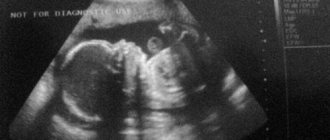Having created such a table, do not forget to note the tenth movement daily, at first it may be the first half hour, but gradually the schedule will shift down to lunchtime.
Regular monitoring of the baby will allow you to immediately notice when the intensity begins to decline. The norm in recent weeks is 1-3 movements per hour, but if the child does not give signals for more than four hours in a row, this is a reason to consult a doctor. Medical consultation is also needed if the baby is too active to exclude possible hypoxia. Using cardiotocography (CTG), the doctor will determine whether there is reason to worry, or whether suspicions, fortunately, are unfounded.
If your baby begins to bother you with kicks less often, but does not forget to remind you of himself from time to time, it means that he is preparing to be born.
In my maternity hospital, fetal movement tests were mandatory. Several times I met expectant mothers filling out a weekly form right outside the doctor’s office. I would not recommend repeating such actions. Observing the movements of the child inside is necessary, first of all, for the birth of a healthy baby, and not for the sake of “the doctor said so, I’ll do it.”
General information about behavior
The first movements in all babies appear after the 8th week of pregnancy. Noticeable movements are noticeable after 24 weeks of gestation. This period is the most active for a child. As the limbs develop and form, the tremors intensify.
Movement during contractions. Contractions are painful sensations similar to spasms that occur before childbirth. When they begin, the embryo tries to actively move for development. The head rests on the bottom of the pelvis, and the legs push off the surface of the uterus. If the fetus calms down or there are no movements, this is not a sign of hypoxia; perhaps it is accumulating strength and energy before the important moment of birth.
In medical practice, there is an indicator of the normal number of kicks before childbirth. The average is two movements in one hour. The minimum rate allowed per day is up to six movements.
Movement control. Constantly recording information in a notebook about the quantity and frequency of movements will only please the doctor at the appointment. This will facilitate the process of monitoring the development of pregnancy. Serious deviations from the norm lead to oxygen starvation of the fetus, that is, hypoxia.
In order to be sure that the situation is normal, you should use the Pearson test. The method involves counting movements up to ten. It is used only from the 28th week of gestation. It is convenient to keep special notes or a diary. It indicates the time and date. There should be ten movements. Repeated shocks one after another are considered to be one. As soon as there are ten movements, the day is closed and they wait for the next one.
Should a baby move during contractions?
Many expectant mothers have no idea whether the baby is moving during contractions, although this is important information, because contractions are a major part of childbirth. They represent a synchronous process of contraction of the smooth muscles of the uterus. Thanks to this, the cervix opens and the baby comes out through the birth canal.
How does a child behave when contractions begin? The fetus begins to feel pressure from all sides of the uterus. As a result, the child moves a lot. The expectant mother may not feel this, since her body is experiencing severe stress caused by the painful shock due to childbirth.
But what happens to the child, why does he start kicking intensely? The onset of contractions leads to changes in the comfortable living conditions in the stomach. The fetus is trying to find a comfortable position again. And the contracting uterus directs it to the exit, which it actually opens. When the baby finds this path, he pushes with all his strength from the bottom of the muscular organ with his limbs.
Another reason why a baby kicks during contractions is lack of oxygen. The blood flow from the placenta slows down. This puts the child in a state of panic, because before contractions he is in the most comfortable and calm position. Immediately after birth, all indicators return to normal.
Strong activity
Normal movements. Activity can continue until childbirth, the fetus constantly changes position inside, causes disturbance, and fusses. On a subconscious level, it is easier for a woman to feel the baby’s movements, thus the mother will be calm. The baby is moving, which means it is alive. This is completely normal behavior. If the number of movements per day is more than six, then there is nothing to worry about. The mother must be sure that everything is fine with the fetus.
What is better activity or calm? Before birth, the baby independently takes the correct position, which will help to be born faster. The day before, the stomach drops, the baby stops squeezing the ribs. Amniotic fluid decreases in quantity, it becomes crowded inside.
Is it true that the baby calms down before birth? Yes, the number of tremors in the last seven days before an important event should be approximately 24 times in twelve hours. This is an indicator of normal child behavior.
How many days before birth does a baby become quiet? 14 days before delivery, the child freezes and begins to accumulate strength. Over the course of 38 weeks, activity is associated with a change in posture. The mother's urge to urinate becomes more frequent with each push, as the fetus puts strong pressure on the bladder while moving.
By week 40, activity subsides and the baby prepares to be born. Activity should appear at certain stages of gestation, and if children calm down for a long time, then this is alarming. Before birth, the baby always becomes quiet.
Fetal position
The next important stage for the fetus is its movement towards the cervix. The child's movements become
translational-rotational. So, the fetus makes its way to the cervix, it is ready to take the starting position. Usually, the baby lies head down.
The next important stage for the fetus is its movement towards the cervix
Many mothers notice that the fetus has descended into the pelvis; during this period, it becomes easier for women to breathe because the baby does not put pressure on the diaphragm, but it becomes more difficult to walk.
Before giving birth, many mothers notice that the fetus has sunk into the pelvis
Reasons for decreased activity
Active behavior does not always indicate serious violations. It is enough that the mother took an inconvenient position for the fetus and the flow of oxygen decreased.
Even in the sixth month, the baby is spacious and comfortable in the mother’s belly for games and movements, after this period the behavior changes, and the fetus calms down. In addition to the fact that the uterus stretches in size, the less time left before birth, the tighter it is inside. Movements become constrained, and when the uterus prolapses, the fetus becomes trapped by the pelvic bones.
Why does a baby become quiet before birth:
- height and body weight increases;
- vertical position;
- When the muscles of the uterus are tense, sensitivity decreases.
The position changes, from horizontal to vertical. At this moment, the child's head is down and his legs are up; movements will continue, but not with such activity. All blows will fall on the lower part of the uterus, since there are fewer nerve endings there, the sensitivity is not high.
A woman’s behavior depends on individual characteristics and pain threshold. Some mothers have a hyperactive baby, others are calmer. Some people can’t stand the pain of blows, but for others it’s like a tickle, nothing more. The calm of a child before birth is associated with the preparatory stage of birth.
Complications
Attention should be paid to sudden unusual changes; they serve as an alarming symptom for health. It is dangerous when a child becomes too active and does not calm down for a long time.
For the study, the cardiography method is used. It recognizes the problem through the baby's heart rate. The method helps to identify suspected oxygen starvation. Hypoxia affects the development of the fetus and leads to complications in the birth process.
Hypoxia is characterized by active, restless behavior of the child. During the period of hypoxia development, the baby should calm down and not manifest itself in actions. Without rapid delivery, the pathology leads to death. If the fetus subsides before birth, then it is necessary to count the number of movements throughout the day.
Causes:
- bleeding;
- diabetes mellitus, anemia, cardiovascular disease;
- placental insufficiency;
- Rh factor conflict;
- umbilical cord compression.
Fetal position before birth. In most women, the child independently takes the correct position. Do not be afraid of the situation when, due to the end of time, the baby still does not take the desired position. The position changes many times throughout pregnancy, the fetus becomes quiet or active from time to time.
How does a child behave before birth?
It is quite natural that in such conditions it is not possible to move much intensively, and it probably does not give much pleasure. Before birth, fetal movements change their character: the baby does not move so often, but his kicks are already distinguished by firmness and confidence. Moreover: right now a little picky person can show his character, demonstrating dissatisfaction with the cramped space.
Mom feels almost every movement: there is absolutely no room left for turns and turns. The next most important movement of the baby will be directed downwards: into the pelvic area towards the cervix. On the eve of childbirth, he directs his head into the pelvis, taking the starting position. You will feel that walking has become not very comfortable, but breathing is much easier than before: your rather large belly no longer props up your chest and does not cause shortness of breath.
More on the topic
Why does the stomach drop before childbirth?
Why is No-shpa prescribed before childbirth?
Bloody discharge before childbirth
First fetal movements during pregnancy
Temperature before birth
Types of provisions
The correct position of the fetus inside is vertical, head down, legs up, arms and legs tightly pressed to the body. In rare cases, the baby does not roll over. For example, he continues to sit on his butt or be in a horizontal position. In the wrong position, it will be difficult for the baby to be born on his own, then doctors perform a caesarean section. The child does not always calm down before birth; it happens that activity does not stop until birth.
The fetus constantly turns over and spins throughout the entire gestation period. If the position still does not want to change, and the due date is approaching, then this indicates a breech presentation.
Causes of presentation:
- too much amniotic fluid and small fetal size;
- low level of amniotic fluid;
- fibroids of the female organ;
- incorrect position of the placenta.
A woman undergoes an ultrasound procedure for a maximum of 34 weeks. The method helps to establish the specific position of the fetus inside the abdomen. In rare situations, the baby takes the final position almost on the eve of birth.
How to help the fetus take the correct position? Mom needs to take a position that will help her stomach move down. To do this, sit on a chair with your stomach to the back. Spread your legs wide and let your stomach seem to sag down. Frequent walks in the fresh air will also help keep your baby healthy. If possible, sign up for classes in the swimming pool for pregnant women.
Swimming on your back is an excellent exercise for keeping your baby comfortable. Under the supervision of a doctor, it is allowed to engage in physical activity, but only with caution. It should be understood that before birth the baby may calm down or, on the contrary, become active. It is necessary to control this period of life.
Treatment
Treatment is selected only by the attending physician, depending on the stage of the disease or complication. Medications are prescribed.
If the activity is too high and does not subside over time, the mother needs to stop being sexually active. If there is a threat of serious abnormalities, the doctor prescribes a caesarean section, artificial birth, or hospitalizes the woman in order to save the fetus. During treatment, medications are administered to maintain optimal fetal functioning. Medicines normalize the flow of oxygen and eliminate hypoxia.
During pregnancy, it is worth paying attention to the behavior of the fetus and carefully monitoring the frequency of movements. The dynamics of the tremors indicate the current condition of the baby, if he is unwell, there are no movements for a long time, or strong abnormal activity is manifested.
When to see a doctor? If there are minor changes in the dynamics of movements, there is no need to rush to the hospital. The subsidence of the fetus is associated with a convenient, comfortable position for it. If less than three tremors are recorded per day, you need to consult a doctor. At the appointment, the child’s condition will be checked using an ultrasound, and heartbeats will be counted.
When the baby is hyperactive and does not calm down, the pain cannot be tolerated; this is associated with the development of hypoxia. Without assistance, the situation ends in death. The mother needs to know if the baby is quiet, she can predict in advance when labor will begin.
In a woman during pregnancy, the behavior of the baby does not depend on multiple pregnancy. If twin babies subside before birth, the situation is similar to a single fetus.
The number of movements is an important sign
After the 37th week of pregnancy, many pregnant women notice that there are fewer movements and the fetus seems to calm down. Sometimes there are periods of excessive activity followed by periods of calm.
Of course, each pregnancy is different for each woman, but on average, at 38-39 weeks of pregnancy, a woman should feel 10 movements of the baby within 6 hours, which turns out to be 1 - 2 movements per hour. It's okay if your baby is not that active, because he needs to gain strength, he can sleep, so he won't move even once in an hour. When he wakes up, he will definitely remind his mother of himself with a slight push. Some babies, on the contrary, are extremely active. This is usually due to the mother’s strong anxiety, which is passed on to the child. That is why try to remain calm, because stress is not necessary for you or your baby.
If the baby does not move for 12-16 hours, or, on the contrary, is very active, contact your doctor, because this activity may be a consequence of hypoxia.
If in the last weeks of pregnancy the child began to behave calmly and became quiet, this means that it is time for you to get ready for the maternity hospital. Do not go far from home unaccompanied; you should forget about long trips.








